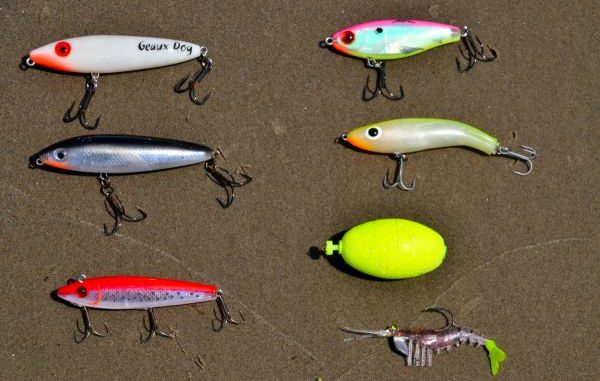
Unlike many Louisiana speckled trout anglers, Sammy Romano prefers plugs over jigs and soft plastics for his speckled trout fishing.
“A huge majority of people who fish in Louisiana don’t realize what they are missing by not using a plug in the surf,” Romano said. “It’s all about the hit: They hit plugs hard in the surf.
“It gets violent.”
Romano divided his choices of lures into four categories:
1) Topwater plugs — “I love to catch fish on topwaters,” Romano said. “It’s the ultimate when you can do it.”
His choices here include MirrOlure She Dogs and Geaux Dogs or Rapala Skitter Walks. The latter is often his choice for calm-water fishing.
The MirrOlures have a higher-frequency rattle that Romano feels work better in rough-water conditions.
He isn’t particular about colors.
“”With topwaters, I think that it’s the cadence of how the lure is fished that is more important than color,” Romano said.
Regardless of his bait choice, he works them the same — walking the dog, with strategic pauses.
2) Suspending plugs — Corky lures are his favorites, followed by MirrOlure MirrOdines.
“I fish any suspending bait made by Corky: Originals, Fat Boys, or Devils,” Romano said. “On 99 days out of a 100, I will have a Corky on my line.”
That said, the Devil is his least-used option.
Fat Boys have more of the shape of pogies, and he likes these most when calmer conditions exist.
He prefers Originals, which have a thinner profile and faster sink rate, when water currents are stronger or the water is slightly rougher.
Because they are slow-sinking baits and must be fished slowly, Corkys in general are best used in calm conditions and moderate to low tide ranges.
“A MirrOdine,” Romano said, “is basically a hard-body Corky that sinks a little faster than a Corky and provides a little more flash for off-color water.
“It’s not a lure that I use a lot, but it’s worth mentioning.”
Romano prefers bright colors for suspending plugs. Pink and chartreuse with pearl sides are Corky favorites, and he likes electric chicken in MirrOdines.
Suspending lures need to be worked fast enough to keep them off the bottom but slow enough to prevent them from popping to the surface. A fisherman will rapidly get the feel for working suspending plugs after a few casts.
3) Sinking plugs — Romano confines his use of sinking plugs, officially called “twitch baits,” to 52MR series or TTR series MirrOlures.
“The only difference between the two is that TTRs have spots,” he explained. “I always use some variety of red and white — red head-and-white body or red back with a white belly and silver sides.”
These lures work pretty much at all times, but he said he favors them in rough surf conditions.
“Sinkers are heavy, so they have to be worked relatively fast,” Romano said. “Vary the speed and action day to day to find what the fish want.”
4) Artificial shrimp under a popping cork — This class of baits is Sammy Romano’s one concession to his preference for plugs over soft plastics on jigs.
Many makers manufacture them, and they all work, he said. He gave Vudu Shrimp, H&H TKO Shrimp and D.O.A. Shrimp as examples.
“They are good search baits,” Romano said. “If the fish are not hitting in a spot and you have to search a lot of water, this is the go-to bait.
“The cork set on the line above simply keeps the lure in the strike zone.”
A strong negative for this type of lure, Romano said, is that fish caught on them are smaller on average than those caught on plugs.
Plus, they just don’t have the panache as hard lures.
“It just isn’t as fun a feeling as the hit on a plug,” Romano said. “It gets boring watching a cork.”
When he’s forced to resort to artificial shrimp, favorite colors are glow, chartreuse and Cajun pepper with a chartreuse tail.